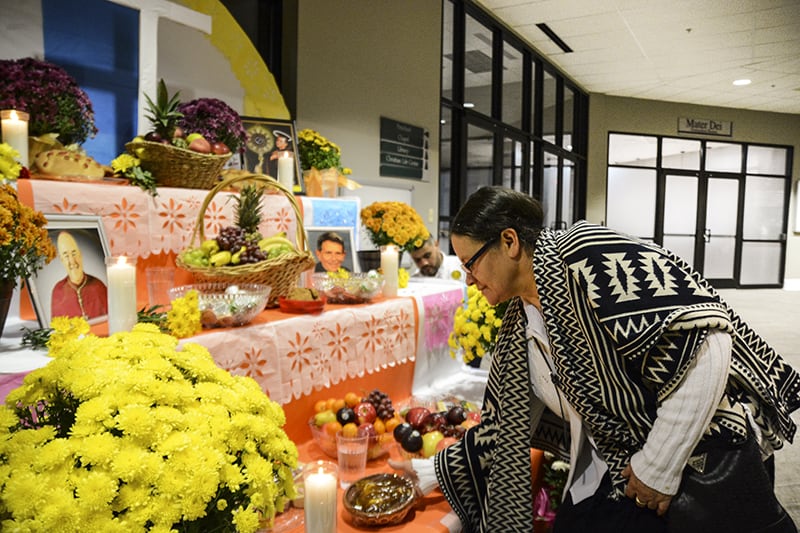
On All Saints Day and All Souls Day, members of the Catholic Church on earth unite in prayer with those who are already in heaven and those still trying to get there.
“It’s in the grace of Christ, in the bond of charity, that we are united with the dead, both those in heaven and in purgatory,” said Father Luke Wilgenbusch, associate pastor at Our Lady of the Lake Church in Hendersonville and associate director of vocations for the Diocese of Nashville. “These two celebrations remind us that death does not separate us from our loved ones.”
It is that bond with loved ones who have passed that is the foundation of the popular Mexican celebration of Dia de Muertos, or Day of the Dead.
“It is a time to pray for family members and to remember them,” Father David Ramirez, diocesan director of Hispanic ministry, said of the Day of the Dead celebrations.
The Masses on All Souls Day, Nov. 2, at Sagrado Corazon Church, when the congregation celebrates the Day of the Dead, are among the most well-attended of the year, Father Ramirez said.
“It’s a joyful time,” he said. “It’s a good festival.”
The many Mexican Americans and Mexican immigrants in the diocese brought the tradition of the Day of the Dead with them to Tennessee. Besides attending Mass, people honor and remember their deceased loved ones by building altars called ofrendas that are decorated with photos of the departed, their favorite meals and drink, skulls made of sugar called calaveras, marigolds and other items.
Sagrado Corazon and Our Lady of Guadalupe Church in Nashville, which both serve the Catholic Spanish-speaking community, typically build ofrendas that members of the congregation decorate. The Nocturnal Adoration Society at Sagrado Corazon will again build the ofrenda there, but Our Lady of Guadalupe will skip that part of the tradition this year because of the COVID-19 pandemic.
People also build and decorate ofrendas in their homes and visit the graves of their loved ones at the cemetery.
“It keeps the memory of their family members alive,” explained Father Alejandro Godinez of Sagrado Corazon.
Both Sagrado Corazon and Our Lady of Guadalupe are scheduling extra Masses for All Saints and All Souls Days to spread out attendance and allow for social distancing in the churches. Our Lady of Guadalupe will have Masses at 6 p.m. and 8 p.m. on Sunday, Nov. 1, and Monday, Nov. 2, and Sagrado Corazon will have Masses at 6 p.m. and 8 p.m. Nov. 2.
“We’re going to be careful,” Father Ramirez said. People will be required to wear masks and keep socially distant. Hand sanitizer will be available for people to use. “We sanitize the church after every Mass,” he added.
“The Church always celebrated All Saints Day, recognizing all the people who are in heaven,” Father Ramirez said. “It’s normal for us the next day (All Souls Day) to celebrate the people who are still trying to get to heaven. We pray for those people, the people in purgatory.”
The Church’s observance of All Saints Day and All Souls Day is a reflection of its teaching on the communion of saints, Father Wilgenbusch said.
“The communion of saints refers to all the men and women who have passed this life and entered into the joy of heaven,” Father Wilgenbusch said. “Heaven is an experience they all enjoy and are united in through the grace that they have in common, and their shared experience of the vision of God.
“Certainly, that same grace unites even those on earth and those who are in purgatory,” Father Wilgenbusch said. “It is one Church with different members,” he said, members on earth, members in heaven, and members in purgatory.
“The same grace that makes the Church holy, it’s that grace that we all hold in common,” a grace that comes from Jesus Christ, he said.
“On All Saints Day we celebrate in a way not only the individual saints, but really the whole group of saints, which is a way to recognize the gift of God that has made holiness possible in so many men and women across the centuries,” Father Wilgenbusch said.
“By celebrating all saints together we point in a more universal way to the power of God’s grace to transform and sanctify every state of life,” he added.
The feast day celebrates not only the saints who have been canonized by the Church, but also “people who won’t be canonized because their holiness was lived in a more hidden way but who are nevertheless experiencing the vision of God,” Father Wilgenbusch said.
“What heaven really is, is the vision of God. Seeing God as he is in himself without a veil is what fulfills us and truly makes us happy,” he said.
All Souls Day, Father Wilgenbusch said, is “an opportunity to remember the importance of praying for those who have died who are still in need of healing and are still making reparation in justice for their sins.”
The prayers of the Church “help them as they make their way to heaven” from purgatory, he said.
One of the differences between the Catholic faith and some other Christian denominations is the Church’s teaching about honoring saints and the Blessed Mother, and praying for their intercession with God.
“We ask for the intercession of the saints because it glorifies God to recognize the power of his grace at work in the lives of the holiest among us,” Father Wilgenbusch said. “By praying to the saints, we recognize their closeness to God, and he is glorified when he gives us graces through their intercession.”
“Honoring the saints doesn’t take anything away from God’s glory because we recognize that what they have done, they’ve done through the power of God’s grace,” he explained. “When we honor a saint, we’re ultimately honoring God who enabled them to live such a holy life.”









